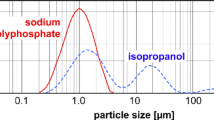This paper presents the results of experimental investigations of the dispersion of quartz particles with their simultaneous modification in a planetary-centrifugal dynamic mill depending on the variation of the time-force regimes of mechanochemical treatment. Nitrogen- and carbon-containing compounds were used as modifiers. The laws of change in the dispersivity, imperfection, and transformation of the surface layer structure and the morphological features of synthesized particles of the composite polymer/mineral structure in the process of mechanochemical treatment have been established. We have shown the relationship between the mechanical action and the piezoelectric response of the system to the process of modification of the newly formed surface of quartz particles and their capsulization into hetero-organic shells, whose composition and structure are determined by both the quality of the material-base and the kind of the modifier.
Similar content being viewed by others
References
A. A. Berlin, S. A. Vol’fson, V. G. Oshmyan, and N. S. Enikolopov, Principles of Creating Composite Polymeric Materials [in Russian], Khimiya, Moscow (1990).
V. V. Boldyrev, E. G. Avvakumov, E. V. Boldyreva, et al., Fundamental principles of mechanical activation, mechanosynthesis, and mechanochemical technologies, in: Integration Projects of the Siberian Branch of the Russian Academy of Sciences, Issue 19 (2009).
T. Heinicke, Tribochemistry [Russian translation], Mir, Moscow (1987).
V. A. Radtsik, I. V. Beresteskaya, and S. N. Kostritsa, Silane group on the silica surface. Recording by the IR spectroscopy method, Kinet. Katal., 39, No. 6, 940–945 (1998).
V. A. Radtsik, Reaction intermediates on the surface of solid bodies, Khim. Fiz., 14, No. 8, 125–135 (1995).
N. N. Mofa, Mechanochemical treatment — a progressive technological process of creating new composite materials, Khim. Khim. Tekhnol. Sovr. Probl., Kazakh. Univ., Almaty (2004), pp. 163–198.
N. N. Mofa, T. A. Shabanova, T. A. Ketegenov, et al., Quartz particles electron-microscopic investigations modified by mechanochemical processing, Eurasion Chem. Tech. J., No. 5, 297–303 (2003).
N. N. Mofa, T. A. Ketegenov, Z. A. Mansurov, and D. W. Soh, Nanocomposite magnetic powder materials using mechanochemical synthesis, Trans. Electron. Mater., 5, No. 1, 24–33 (2004).
K. Andrews, D. Dyson, and S. Keown, Electronograms and Their Interpretation [Russian translation], Mir, Moscow (1971).
Z. A. Mansurov, N. N. Mofa, and T. A. Shabanova, Hybride, nanostructurized materials of special purpose on the basis of silicon dioxide, Adv. Eng. Ceram. Compos., 484, 230–240 (2011).
Z. A. Mansurov, T. A. Shabanova, and N. N. Mofa, Synthesis and Technology of Nanostructurized Materials: A Course of Lectures [in Russian], Kazakh. Univ., Almaty (2012).
R. Iler, Silica Chemistry [Russian translation], Pts. 1, 2, Mir, Moscow (1982).
A. A. Urusovskaya, Electric effects connected with plastic deformation of ionic crystals, Usp. Fiz. Nauk, 96, Issue 1, 39–60 (1968).
L. A. Zaitseva, Influence of a layer of hot electrons near the surface on the thermodynamic energy of semi-infinite solid bodies, Khim. Fiz., 21, No. 2, 15–25 (2002).
V. V. Zyr’yanov, A model of the reaction zone under mechanical loading of powders in a planetary mill, Neorg. Mater., 34, No. 12, 1525–1534 (1998).
L. A. Bol’shov and A. A. Krivchenko, Initiation of a nonlinear diffusion wave during electrotransfer in monatomic fi lms, Fiz. Tverd. Tela, 17, Issue 3, 649–654 (1975).
Yu. N. Zhugin, Behavior of α-quartz at high dynamic and static pressures: new results and concepts, Khim. Fiz., 14, No. 1, 69–74 (1995).
Author information
Authors and Affiliations
Corresponding author
Additional information
Translated from Inzhenerno-Fizicheskii Zhurnal, Vol. 86, No. 4, pp. 793–800, July–August, 2013.
Rights and permissions
About this article
Cite this article
Mansurov, Z.A., Mofa, N.N. & Shabanova, T.A. Mechanochemical treatment, specific features of the structure and properties, and reactivity of SHS systems based on natural materials. 1. Mechanochemical synthesis of disperse nanostructured composite quartz-based systems. J Eng Phys Thermophy 86, 848–855 (2013). https://doi.org/10.1007/s10891-013-0903-2
Received:
Published:
Issue Date:
DOI: https://doi.org/10.1007/s10891-013-0903-2




